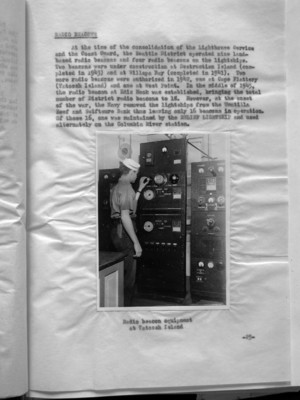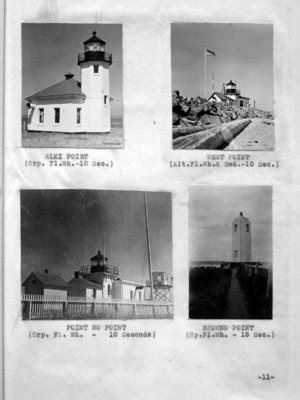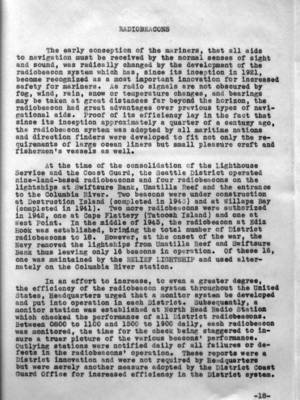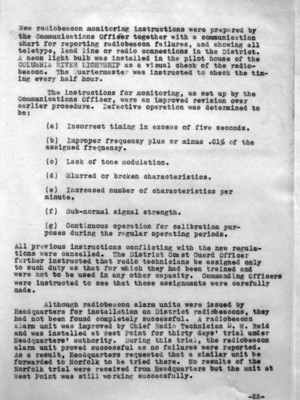Pages That Mention West Point
Coast Guard District narrative histories 1945
8
At the time of the consolidation of the Lighthouse Service and the Coast Guard, the Seattle District operated nine land-based radio beacons and four radio beacons on the lightships. Two beacons were under construction at Destruction Island (completed in 1943) and at Willapa Bay (completed in 1941). Two more radio beacons were authorized in 1942, one at Cape Flattery (Tatoosh Island) and one at West Point. In the middle of 1945, the radio beacon at Ediz Hook was established, bringing the total number of District radio beacons to 18. However, at the onset of the war, the Navy removed the lightships from the Umatilla Reef and Swiftsure Bank thus leaving only 16 beacons in operation. Of these 16, one was maintained by the RELIEF LIGHTSHIP and used alternatively on the Columbia River station.
(Photo inserted here)
Radio beacon equipment at Tatoosh Island
-25-
21
In the quite rapid succession, Umpqua River, Willapa Bay, Smith Island, Ediz Hook, Cape Arago, Cape Blanco, Point No Point, Point Wilson, and Yaquina Bay Lighthouses were built. In 1879, construction began on the Tillamook Rock Beacon.
Tillamook Rock Lighthouse was one of the most famous as well as one of the most exposed stations in the Lighthouse Service, set on a great precipitous rock lying a mile offshore from Tillamook Head on the Oregon Coast. A dark cloud of ill omen shadowed the station as, in the landing of the construction party, the superintendent was swept by a great wave into the sea and drowned. Almost insurmountable obstacles faced the engineers, for the entire top of the rock mass had to be blasted level to provide space for the lighthouse and its accompanying structures. Heavy seas continually washed over the Rock carrying away half finished foundations, equipment and endangering the lives of the entire work party. Although the light stood 133 feet above the water, on many occasions tremendous waves swept completely over the station carrying large fragments of rock which caused considerable damage to the station. On one such occasion, a rock weighting 135 pounds was hurled through the roof of the building and into the quarters below, causing extensive damage. Another time, the sea tossed a boulder through the lantern, extinguished the light and flooded the dwelling below.
West Point, built in 1881, Alki Point and Brown Point, built in 1887 and Destruction Island, built in 1891, were the next light stations to be erected. Here again, at Destruction Island, treacherous seas made landings difficult except in calm weather, so the "basket" and boom were again called upon for safe landings on the station. 14 other lighthouses were established in the Seattle District, the last being the Lim Kiln structure in 1914. Strangely enough, the Lime Kiln Lighthouse was the last light station in the District operating an oil lantern. An attempt was made to electrify the light by extending commercial power to the Station but the Power Company was unable to furnish sufficient current; in the same regard, poles had to be set in a solid rock and the cost and labor for this were almost prohibitive. A request was made for Headquarters' approval to install a power plant at the unit but this was not commensurate with Headquarters' policy so the light remained an incandescent oil vapor type. This type, familiarly known as i.o.v., gave good service although its range could not match that of the newer electric light. The old i.o.v. light came in two sizes and was approximately equivalent
-2-
30
(Image top left)
ALKI POINT (Grp. Fl.Wh.-10 Sec.)
(Image top right)
WEST POINT (Alt.Fl.Wh.& Red.-10 Sec.)
(Image bottom left)
POINT NO POINT (Grp. Fl. Wh. - 10 Seconds)
(Image bottom right)
BROWNS POINT (Gp.Fl.Wh. - 15 Sec.)
37
The early conception of the mariners, that all aids to navigation must be received by the normal senses of sight and sound, was radically changed by the development of the radiobeacon system which has, since its inception in 1921, become recognized as a most important innovation for increased safety for mariners. As radio signals are not obscured by fog, wind, rain, snow or temperature changes, and bearings may be taken at great distances far beyond the horizon, the radiobeacon had great advantages over previous types of navigational aids. Proof of its efficiency lay in the fact that since its inception approximately a quarter of a century ago, the radiobeacon system was adopted by all maritime nations and direction finders were developed to fit not only the requirements of large ocean liners, but small pleasure craft and fisherman's vessels as well.
At the time of the consolidation of the Lighthouse Service and the Coast Guard, the Seattle District operated nine-land-based radiobeacons and four radiobeacons on the lightships at Swiftsure Bank, Umatilla Reef and the entrance to the Columbia River. Two beacons were under construction at Destruction Island (completed in 1943) and at Willapa Bay (completed in 1941). Two more radiobeacons were authorized in 1842, one at Cape Flattery (Tatoosh Island) and one at West Point. In the middle of 1945, the radiobeacon at Ediz Hook was established, bringing the total number of District radiobeacons to 18. However, at the onset of the war, the Navy removed the lightships from Umatilla Reef and Swiftsure Bank thus leaving only 16 beacons in operation. Of these 16, one was maintained by the RELIEF LIGHTSHIP and used alternately on the Columbia River station.
In an effort to increase, to even a greater degree, the efficiency of the radiobeacon system throughout the United States, headquarters urged that a monitor system be developed and put into operation in each District. Subsequently, a monitor station was established at North head Radio Station which checked the performance of all District radiobeacons. Between 0800 to 1100 and 1500 to 1900 daily, each radiobeacon was monitored, the time for the check being staggered to insure a truer picture of the various beacons' performance. Outlying stations were notified daily of all failures or defects in the radiobeacons' operation. These reports were a District innovation and were not required by Headquarters but were merely another measure adopted by the District Coast Guard Office for increased efficiency in the District system.
-18-
41
New radiobeacon monitoring instructions were prepared by the Communications Officer together with a communication chart for reporting radiobeacon failures, and showing all teletype, land line or radio connections in the District. A neon light bulb was installed in the pilot house of the COLUMBIA RIVER LIGHTSHIP as a visual check of the radiobeacon. The Quartermaster was instructed to check the timing every half hour.
The instructions for monitoring, as set up by the Communications Officer, were an improved revision over earlier procedure. Defective operation was determined to be:
(a) Incorrect timing in excess of five seconds.
(b) Improper frequency plus or minus .01% of the assigned frequency.
(c) Lack of tone modulation.
(d) Slurred or broken characteristics.
(e) Increased number of characteristics per minute.
(f) Sub-normal signal strength.
(g) Continuous operation for calibration purposes during the regular operating periods.
All previous instructions conflicting with the new regulations were cancelled. The District Coast Guard Officer further instructed that radio technicians be assigned only to such duty as that for which they had been trained and were not to be used in any other capacity. Commanding Officers were instructed to see that these assignments were carefully made.
Although radiobeacon alarm units were issued by Headquarters for installation on District radiobeacons, they had not been found completely successful. A radiobeacon alarm unit was improved by Chief Radio Technician D. W. Reid and was installed at West Point for thirty days' trial under Headquarters' authority. During this trial, the radiobeacon alarm unit proved successful as no failures were reported. As a result, Headquarters requested that a similar unit be forwarded to Norfolk to be tried there. No results of the Norfolk trial were received from Headquarters but the unit at West Point was still working successfully.
-22-




